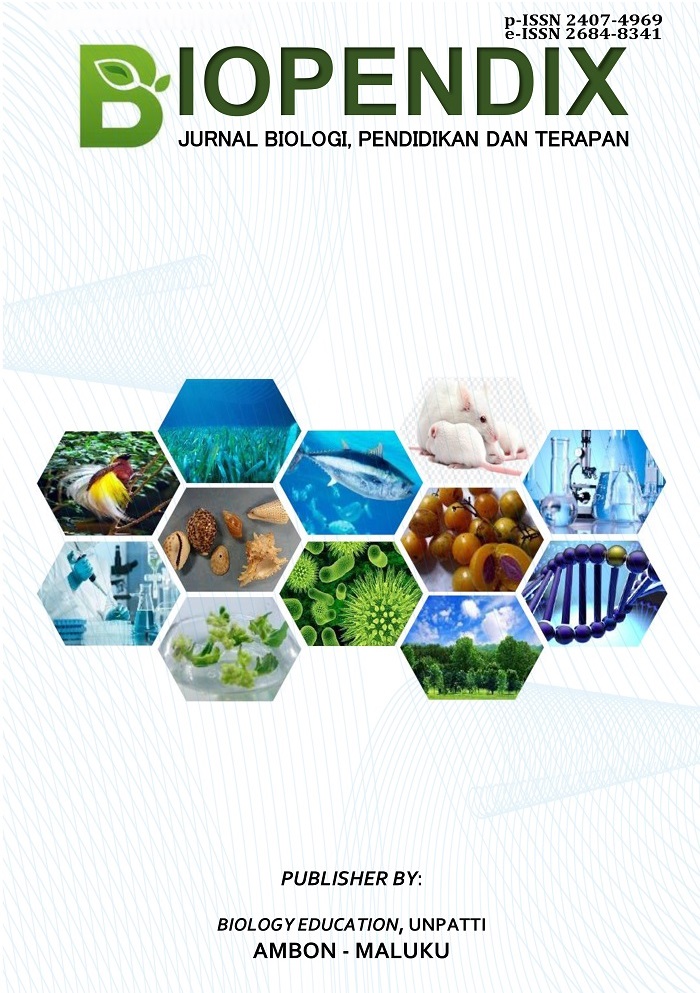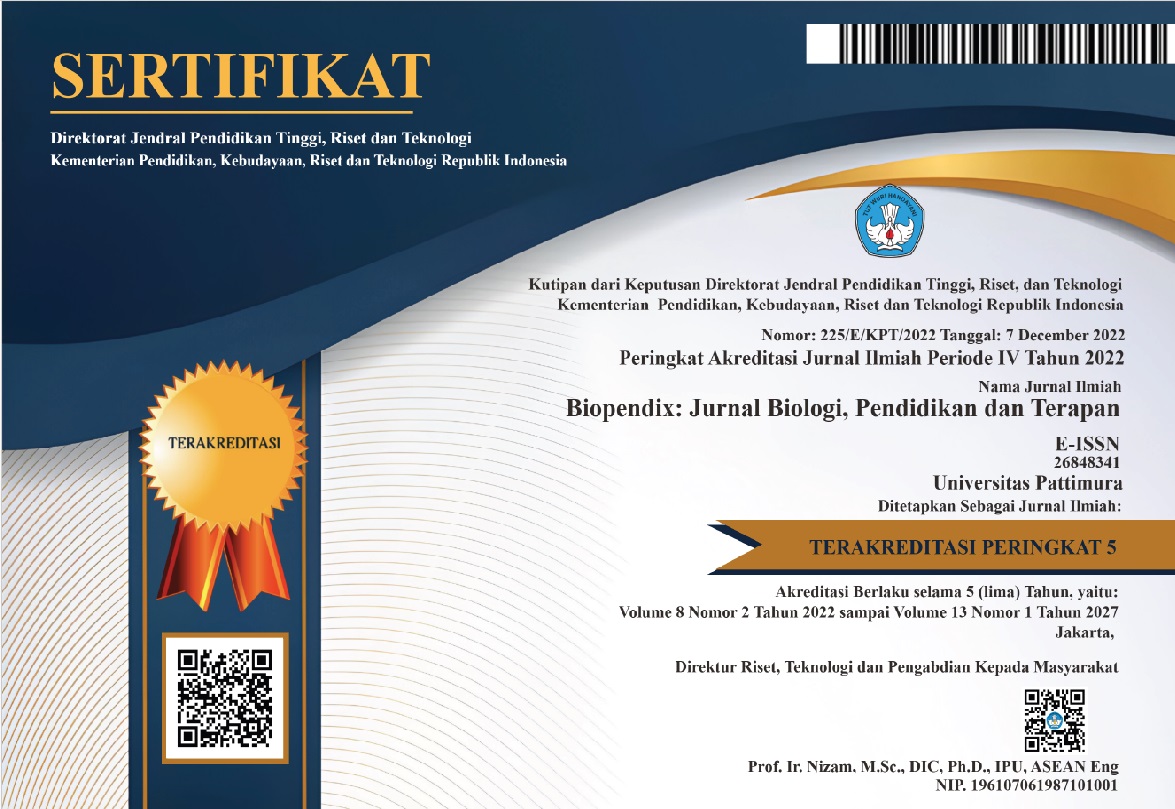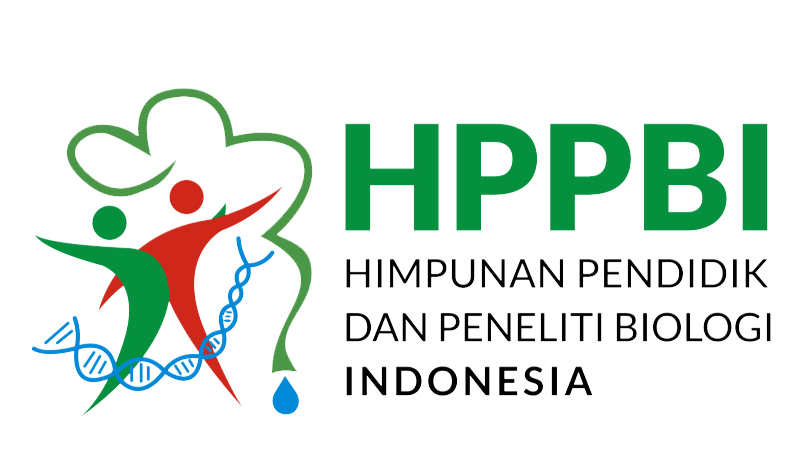Analysis of Potassium and Iron (Fe) Contents of Red Salak Fruit (Salacca edulis Reinw) Seram Regency, Western Part of Maluku Province
Abstract
The snake fruit plant called red snake fruit can be found throughout Maluku, especially in Taniwel District in West Seram Regency (SBB). The flesh of the fruit is thick and dark yellow with a red tinge. The cultivation centers of red snake fruit in Riring Village and Buria Village are at different altitudes, which allows for differences in the content of primary metabolites, especially potassium content, in red snake fruit plants. The focus of the study was the potassium and iron (Fe) content of red snake fruit in the highlands (Riring Village) and lowlands (Buria Village). The first step in conducting potassium content analysis is the process of preparing red snake fruit, where the skin and flesh are peeled and separated. After that, the grass is dried for six times twenty-four hours in an oven. After that, the grass is ground into powder. The potassium content test stage uses the atomic absorption spectrophotometry (AAS) technique. Here, this step produces a solution that is used to calculate the levels of potassium and iron (Fe). The results showed that red snake fruit was positive for potassium in two different locations at different altitudes. Negeri Buria has the highest potassium content of 2.21715% and Negeri Riring has the lowest potassium content of 1.9121%. Riring Village has an iron (Fe) content of 0.0143mg/L, while Buria Village has an iron content of 0.0157mg/L. Negeri Riring has the highest potassium content of 2.21715% and Negeri Riring has the lowest potassium content of 1.9121%.
Downloads
References
Akhir, N. (2017). Growth Response of Two Varieties Chrysanthemum (Chrysanthemum sp.) on Some Media Composition. 7(3).928-935. https://doi.org/10.18517/ijaseit.7.3.1775
Bagus, R., Astomo, W., Syahputra, A., Mahmudah, A., & Surabaya, U. M. (2023). Talak Organik Wonosalam: Produk Inovasi Teh Dari Limbah Kulit Salak Untuk Umkm Desa Wonosalam Kabupaten Jombang. Jurnal Abdikarya, 5(1), 1-10. https://doi.org/10.30996/abdikarya.v6i1.8108
Čepková, P. H., Jágr, M., Janovská, D., Dvořáček, V., Kozak, A. K., & Viehmannová, I. (2021). Comprehensive mass spectrometric analysis of snake fruit: Salak (salacca zalacca). Journal of Food Quality, 2021. https://doi.org/10.1155/2021/6621811
Herawati, W., Amurwanto, A., Nafi’ah, Z., Ningrum, A. M., & Samiyarsih, S. (2018). Variation analysis of three banyumas local salak cultivars (Salacca zalacca) based on leaf anatomy and genetic diversity. Biodiversitas, 19(1), 119–125. https://doi.org/10.13057/biodiv/d190118
Kelishadi, R., Abbaspour, N., & Hurrell, R. (2014). Review on iron and its importance for human health. In Article in Journal of Research in Medical Sciences. https://www.researchgate.net/publication/261957307
Kimia, S., Pada, T., Vegetasi, B. T., Rosalina, F., & Maipauw, N. J. (2019). Sifat Kimia Tanah pada Beberapa Tipe Vegetasi, 11(1), 1-9. https://doi.org/10.33506/md.v11i1.423
Kurnia Sari, D., Rachmawanti Affandi, D., & Prabawa Jurusan Ilmu Teknologi Pangan Fakultas Pertanian, S. (2019). Pengaruh Waktu dan Suhu Pengeringan Terhadap Karakteristik Teh Daun Tin (Ficus carica L.) Effect of Drying Time and Temperature On The Characteristics Of Fig Leaf Tea (Ficus carica L.). In Jurnal Teknologi Hasil Pertanian: Vol. XII 12(2), 68-77.https://doi.org/10.20961/jthp.v12i2.36160
Mandei, J. H., Reny Sjarif, S., Tumbel, N., Riset, B., Standardisasi, D., Manado, I., Raya, J., & Dua, P. (2021). Pengaruh Jenis Asam Dan Ph Terhadap Aktivitas Enzim Dehidrogenase Dan Indeks Browning Daging Buah Salak Pangu Effect Of Acid Type And Ph On Dehydrogenase Enzyme Activity And Browning Index Of Zalacca Flesh. Jurnal Penelitian Teknologi Industri, 13(1), 11-18. 10.33749/jpti.v13i1.7036
Nanuayo, S., Sahusilawane, R. M., Sinmiasa, F. J., Andrea Tamaela, K., Studi Pendidikan Biologi, P., Gotong Royong Masohi Jln Trans Seram, S., Masohi, K., Maluku Tengah-Indonesia, K., & Artikel, I. (2023). Development of Ethnobotany E-Modules Based on Local Potential of Noaulu-Maluku Tribe for Senior High School Students. Biodik: Jurnal Ilmiah Pendidikan Biologi, 9(4),24 - 30. https://doi.org/10.22437/biodik.v9i4.29407
Rahmah, S., Umar, H., Kehutanan, J., Kehutanan, F., Tadulako Jl Soekarno-Hatta Km, U., & Tengah, S. (2014). Warta Rimba Sifat Kimia Tanah Pada Berbagai Tipe Penggunaan Lahan Di Desa Bobo Kecamatan Palolo Kabupaten Sigi.
Sembiring, G. M., & Maghfoer, M. D. (2018). Pengaruh Komposisi Nutrisi dan Pupuk Daun pada Pertumbuhan dan Hasil Tanaman Pakcoy (Brassica rapa L.var. chinensis) Sistem Hidroponik Rakit Apung. PLANTROPICA: Journal of Agricultural Science, 3(2), 103–109.
Van Beusekom, A. E., González, G., & Rivera, M. M. (2015). Short-term precipitation and temperature trends along an elevation gradient in northeastern puerto rico. Earth Interactions, 19(3), 3–33. https://doi.org/10.1175/EI-D-14-0023.1
Wijayanto, N., & Wilarso Budi, S. R. (2019). Characteristics of Soil Chemical Properties and Soil Fertility Status of Vegetables Agroforestry Based on Eucalyptus Sp. Jurnal Silvikultur Tropika, 10(02), 63–69. https://doi.org/10.29244/j-siltrop.10.2.63-69
Copyright (c) 2025 Louvenska Nona Latupeirissa, Alwi Smith, Eifan Boyke Pattiasina, Rufiati Simal

This work is licensed under a Creative Commons Attribution-ShareAlike 4.0 International License.
Authors who publish with BIOPENDIX: Jurnal Biologi, Pendidikan dan Terapan agree to the following terms:
- Authors retain copyright and grant the journal right of first publication with the work simultaneously licensed under Creative Commons Atribution-ShareAlike 4.0 International License (CC BY-SA 4.0) that allows others to share the work with an acknowledgment of the work's authorship and initial publication in this journal.
- Authors are able to enter into separate, additional contractual arrangements for the non-exclusive distribution of the journal's published version of the work (e.g., post it to an institutional repository or publish it in a book), with an acknowledgment of its initial publication in this journal.
- Authors are permitted and encouraged to post their work online (e.g., in institutional repositories or on their website) prior to and during the submission process, as it can lead to productive exchanges, as well as earlier and greater citation of published work.





 2
2







